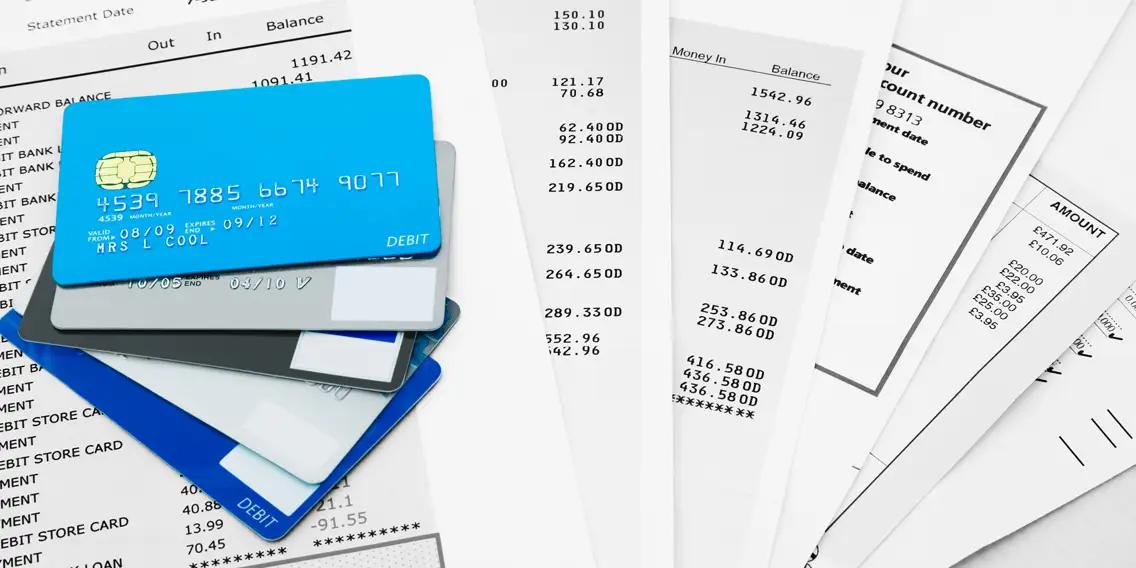Personal Finance
5 Financial Resolutions for the New Year
What you'll learn: How to set financial resolutions for the new year
EXPECTED READ TIME: 11 MINUTES
Setting resolutions is a great way to start a new year off on a positive note — and what better resolution could you set than making some positive changes to your finances?
If you’re not sure where to start with resolutions, have no fear. We’ll break down the five most popular financial goals people like to set for the new year. Which ones will you try, come January?

1. Create a Budget
If personal finance were like building a house, a budget would be the foundation. It’s a roadmap for how you get your money and what you do with it. Without that plan, you can’t know if any other financial decisions you make are realistic.
Creating a budget is easier than you might think — you can make one from scratch in 4 simple steps:
- Gather financial documents
- Choose a budgeting strategy
- Determine your income
- List your expenses
The hard part for many people is that budgets can feel constricting and hard to stick to. If that sounds familiar, consider trying the envelope method. For some people, seeing the cash in an envelope dwindle helps them control their spending.
Paying off debt is one of the most popular financial resolutions, year after year.
2. Manage Your Debt
Debt can be a powerful financial tool, but it can also be a barrier to some financial goals. This is why paying off debt is one of the most popular financial resolutions, year after year. In fact, a recent study by The Motley Fool revealed that paying off debt was the top financial goal for Americans in 2024.
Adding Up and Analyzing Your Debt
The first step in managing debt is calculating how much debt you have and what kind of debt it is. Often, we think of all debt as bad, but there is such a thing as good debt. Before you create a debt management plan, it can help to sort your debt.
Debt is usually considered good if it is an investment that will likely increase your net worth or enhance your life. It generally has lower interest rates, helps build your credit, and is easier to manage. In contrast, bad debt comes with higher interest rates and is usually used for discretionary spending.
Choosing a Debt Management Plan
Once you know what kind of debt you have, you can create a debt management plan. A good plan will help you maintain regular payments on your good debt (such as auto loans or mortgages) while paying down bad debt (like credit cards). There are four main strategies for paying off debt:
- Avalanche method
- Snowball method
- Balance transfer
- Consolidation
While each plan has its advantages, the best strategy is the one you will actually follow through on. As you plan, keep in mind that secured and installment debt is generally better debt. In most cases, you want to prioritize paying off unsecured, revolving debt.
The best strategy is the one you will actually follow through on.
Secured vs. Unsecured Debt
Secured debt relies on collateral — something of value that can be taken as compensation if you do not repay your debt. Unsecured debt does not rely on collateral.
|
Type of Debt |
Approval depends on |
Examples |
|---|---|---|
|
Secured |
Collateral, credit score, income |
auto loans, mortgages, home equity loans, HELOCs |
|
Unsecured |
Credit score, income |
credit cards, personal loans, personal lines of credit, student loans |
Installment vs. Revolving Debt
Installment debt is repaid with set payments at regular intervals. Revolving debt doesn’t have a set repayment period or term for the loan.
|
Type of Debt |
Payment Schedule |
Examples |
|---|---|---|
|
Installment |
Set payment at regular intervals, usually monthly; set term |
auto loans, mortgages, home equity loans, HELOCs, personal loans, student loans |
|
Revolving |
Variable payment due at regular intervals, usually monthly; no set term |
credit cards |
3. Optimize Your Portfolio
Net worth is the difference between the value of your assets (valuable things you own like your house or checking account) and the total of your debts. Your net worth is usually lower when you’re younger and grows as you age and build wealth.
It’s important not to put too much stock in a number, but a better net wealth is one indicator that you’re ready to face financial challenges and make big financial decisions. You can improve your net worth by growing your assets.
Net worth is the difference between the value of your assets (valuable things you own like your house or checking account) and the total of your debts.
Choose the Right Investment Tools for Your Goals
The word “investment” encompasses everything from savings accounts to more complex tools like stocks and Real Estate Investment Trusts (REITs). Some of these investments are very low risk and require little research, while others carry much greater risks and require a deeper understanding of markets. Before choosing an investment tool, ask yourself some questions:
- How much money do you have to invest?
- How much research are you willing to do?
- How much financial risk can you handle?
- How liquid do you want your assets to be?
How Different Types of Investments Compare
Some investments are more accessible, while other require more specialized knowledge or more money to be profitable. Investments also vary by how much risk they carry. Which investments best fit your strategy?
|
Type of Investment |
Yield |
Difficulty |
Risk |
Cost to Start Investing |
Liquidity |
|---|---|---|---|---|---|
|
High-Yield Savings Accounts |
Low |
Low |
None |
Very low |
Highly liquid |
|
Bonds and Bond Index Funds |
Low |
Low |
None |
Low |
Illiquid |
|
Dividend Stocks |
Very low to very high |
Medium to high |
High |
Medium to high |
Highly liquid |
|
Dividend Index Funds and Exchange Traded Funds (ETFs) |
Low to high |
Low |
Low |
Low to medium |
Highly liquid |
|
Real Estate Investment |
Low to very high |
Medium to high |
Medium |
Low to high |
Highly liquid |
|
Trusts (REITs) |
|
|
|
|
|
Diversify Your Assets
Assets can be divided into different classes such as stocks, bonds, and commodities. Diversifying your investments by putting money into different asset classes reduces risk. After all, when one part of the market is down, another part might be up. Investing in ETFs can be a simple way to diversify your investments.
Review Your Asset Allocation
Asset allocation refers to how the money in your investments is divided up among different assets. Investment strategists usually encourage people to move more of their money into safer investments as they edge closer to retirement. This plan won’t necessarily grow your money as much, but it will better protect your money against losses.
Investing in ETFs can be a simple way to diversify your investments.
4. Prepare for the Unexpected
Life is full of surprises, and expensive surprises can really undermine your financial goals. But with a little preparation, you can offset those unexpected costs.
Start an Emergency Fund
An emergency fund is money saved for essential, unexpected expenses. Usually, these funds are kept in a savings account so they’re easily accessible and earn dividends (also known as interest), but you can also keep them in a money market or certificate account. The important thing is that you keep your emergency fund separate from the rest of your money.
Experts usually advise that you save enough money to cover your essential expenses for 3 to 6 months. Even if you have to start small, saving a small amount from each paycheck will give you something to fall back on in a pinch.
Keep your emergency fund separate from the rest of your money.
Know When to Use Your Emergency Fund
Nothing is more tempting than a big pile of savings you’ve sat on for months or years. But if you decide to spoil yourself with an expensive present, you may not have money to fall back on during an emergency. This is why it’s important to separate your emergency fund from other savings you might use for discretionary spending.
So, when do you use your emergency fund? This varies some from person to person, but in general emergency funds should be for expenses that:
- You couldn’t plan for
- You can’t avoid
- Are time sensitive
- Are necessary
5. Plan for Your Future
A new year means you’re a year older, and that’s a good reason to think about retirement and estate planning. While these can be complicated — and intimidating — financial concepts, creating a plan and sticking to it consistently will help you be successful.
A new year means you’re a year older, and that’s a good reason to think about retirement and estate planning.
Save for Retirement
Experts have created benchmarks to help you determine whether you’re on track to meet your retirement goals. While starting early gives you a huge advantage, starting late doesn’t mean you won’t have the retirement of your dreams. If you’ve fallen behind, there are steps you can take now to catch up.
Everyone can save for retirement, even if you don’t have an employee-sponsored 401(k) or equivalent account. Individual Retirement Accounts (IRAs) are a great alternative or supplement to a 401(k), as are Health Savings Accounts (HSA) and Flexible Spending Accounts (FSAs).
Plan for Your Estate
Estate planning is one of the best gifts you can leave your loved ones because it can minimize conflict and reduce stress for them. Many people put off estate planning because it’s intimidating, but working with a financial advisor, estate planner, or lawyer can help you navigate the process. You can also do it yourself online.
You can start by updating your beneficiaries on your bank accounts, insurance plans, and retirement accounts, but you’ll need a will that explains what you want to happen to your assets once you’re gone. Depending on your situation, you may also need:
- Healthcare directives that tell your relatives what you want to happen if you become too sick or unable to make decisions
- A power of attorney that allows a family member or friend to act on your behalf
- Trusts that manage your property for your heirs
Permanent or whole life insurance covers you for your entire life and grows savings over time.
Purchase Life Insurance
Life insurance covers the costs that are left after you pass, but it can also provide non-taxable money for your heirs. Once you choose a policy, you’ll pay a monthly premium. Your family will then receive a predetermined amount when you die.
The cost of life insurance varies depending on factors like your lifestyle, age, and the amount of coverage you choose. It can also vary by type. There are two main types of life insurance to choose from:
- Term life, which is more affordable and usually sold to younger people in good health. It only pays out if you die during a certain timeframe.
- Permanent or whole life, which covers you for your entire life and grows savings over time. It is usually more expensive than term life.
The Takeaway
Financial resolutions help you take stock of your money habits and commit to healthy changes. By setting financial resolutions now and committing to them, you’re laying the groundwork to make your dream life your reality.
Explore Your Savings Options
Discover the diverse offering of products, services, and support available to our members.




